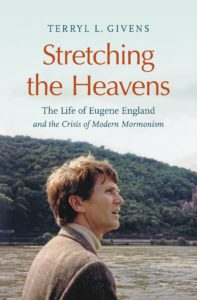Title: Stretching the Heavens: The Life of Eugene England and the Crisis of Modern Mormonism Author: Terryl Givens
Publisher: University of North Carolina Press
Genre: Religious Non-Fiction
Year Published: 2021
Number of Pages: 330
Binding: Hardback
ISBN: 9781469664330
Price: $34.95
Reviewed by Doug Christensen for the Association for Mormon Letters
I was a student in Eugene England’s “Mormon Literature” course in 1989. I was a newly returned missionary and a freshman at BYU. Professor England’s enthusiasm and curiosity, along with the reading and learning we did in class, changed me. The class awakened me to new questions, new problems, and a new way of being Mormon. We read The Giant Joshua, Backslider, Goodbye to Poplar Haven, and many other books and essays I had never heard of. About eight years later, not long before Gene left BYU, I stopped by his office with a friend. We sat on his office floor (characteristically cluttered with dozens of projects and aspirational piles of things to read) for at least an hour discussing his work and his fears that things were not going in the right direction for him at BYU. He repeated something I had heard him say before: “After graduate work at Stanford, I was too Mormon for the University of Utah, and not Mormon enough for BYU.”[i] Around the same time, my brother and I went to hear him give a presentation at BYU, and he read his poem “Kinsman.” I was struck by those last stanzas, that sacred scene where a father, kneeling in the wheat field with his son, prays over his crop and over his boy. Each encounter with Professor England pulled me further into his orbit.
“Kinsman” tells readers so much about Eugene England, and in his recent biography, Stretching the Heavens: The Life of Eugene England and the Crisis of Modern Mormonism, Terryl Givens likewise captures the complex nature of Gene’s life. It is no easy task to review Terryl Givens’ work because his research is so careful and holistic; it feels daunting to do his work justice in a few paragraphs, but Givens begins this biography recognizing a similar challenge: to do justice to a life like England’s in a few hundred pages. Just as this review has taken me longer than usual to get around to writing, Givens at first hesitated and then conceded to write the biography when he had time to give his whole heart to this reflection on England’s life and his contributions to the world.
In the first few chapters, he covers England’s early years, dating, courtship, and marriage to Charlotte Hawkins (affectionately, Sholly), as well as their two-and-a-half-year mission to Samoa together. Chapter 3 ventures into the issues. After a year at MIT and two years at George Airforce base in Victorville, California, Eugene accepted the prestigious Danforth Fellowship at Stanford, under the esteemed instruction of renowned author Wallace Stegner. It was while a graduate student at Stanford that the Vietnam War reached its climax and England became convinced, as he explains, that the “government was lying about the Tonkin Gulf Incident—and suddenly my whole world shifted” (Givens 43). It is fair to say that at this pivotal time in his life, Eugene England became a conscientious objector in more ways than one. Because of his anti-war status, “England received his first of many letters, warning him against rocking the boat as a church educator. England didn’t heed the caution—and a pattern was established that would be repeated countless times” (44). Givens catalogues the contextual backdrop of church education that England would test throughout his life, with only modest success. More often than not his efforts to succeed within the system resulted in one step forward and two steps back. In other words, for all his notable friends in high places, England developed a habit of challenging authority, rarely taking no for an answer and often compromising trusting relationships with apostles and general authorities. Givens see this pattern as one born too often of incorrigible naivete. He notes repeatedly that “England’s obliviousness to clear and loud signals is hard to fathom” (134). However, another way to see England’s lack of self-awareness might be something closer to guilelessness and stubborn optimism than to bald naivete.
In addition to his anti-war stance, England felt moral outrage over all injustices relating to race, class, and gender. He wrote (and published as a founder and editor of “Dialogue, a Journal of Mormon Thought”), landmark essays on race and the priesthood[ii], he wrote about women[iii], about polygamy, about the nature of God, and the nuances of atonement (to limited success in terms of orthodox acceptance).[iv] Givens’ work demonstrates how along the way, writing, publishing, teaching, and gathering people together for dialogue (on the page and in-person), Eugene England longed to be understood, longed to understand, and in the spirit of these aspirations, he communicated openly and sincerely with apostles and general authorities like Bruce R. McConkie, Boyd K. Packer, Neal L. Maxwell, Dallin H. Oaks, Jeffrey R. Holland, and perhaps most often, his former institute teacher Marion D. Hanks. Givens laces these communications between the chronological development of England’s publications and activist efforts which shows, as Givens notes, a different Church landscape where Church leaders more readily communicated personally to individual members, even over controversial topics and questions. The organization of these communications along the continuum of England’s development as a theologian suggests that his desire for institutional approval probably interfered with his goals more than it promoted them. It was only after distancing himself from “Dialogue” that he finally secured employment at BYU. But his tenure there was never comfortable and never completely settled.
Givens observes all the reasons for England’s unsettled state, characterizing him as someone caught in the crisis of a people who have a “hyper-Protestant sensibility operating within a hyper-Catholic structure” (171). Givens sees England in that crucible of post Reformation freedom to honor the dictates of one’s own conscience while genuflecting before the power of the institutional Church, in his case, a post-Reformation church whose institutional revelation and authority trumped personal revelation, while still encouraging personal revelation. The way Givens tells this story under the section heading: “Conscience and Authority”[v] suggests that it probably did not help England to have personal and first-hand exchanges with those in the leading councils of the church—both sides caught in a double bind, a dilemma as old as Hus, Luther, and Tyndale. On the other hand, it is possible that his tenure at BYU lasted as long as it did because he had some of the luck of Luther with his Frederick the Wise, as opposed to Hus and Tyndale facing the full measure of the institution with few to spare them from the flames.
England’s legacy cannot be limited to his writing, but it is in his essays that readers will locate his central contribution. He was a doting husband, a caring father, a dedicated gatherer, a consummate humanitarian, a devoted fly fisherman, a serious listener, a house and cabin builder, and many other things, but he was a serious writer and an unusually bold advocate for the personal essay. According to Phillip Barlow, “Gene never had a thought he didn’t write about” (183). Whether he was anointing the hood of his Chevrolet (on the Lord’s errand, of course), being duped by con artists on the streets of New York, or thinking carefully about the people of the Church as both the Church and the gospel i.e. the body of Christ, not to mention his probing meditation on the weeping God of Mormonism, England worked out the vicissitudes of a pragmatic path to salvation on paper, most often in essays. England’s obituary (which has yellowed since I hung it on my office wall in 2001) says that Gene would take people on impossible hiking trails if they were willing to come along. This seems like an appropriate metaphor for his writing. Some of his theologizing got him into trouble, much of it raised eyebrows, but his only real goal and Givens communicates this eloquently, was to invite the reader into conversation with him, into dialogue. Elder McConkie rejected England’s characterization of eternal progression, especially for the progression of God. Elder Maxwell questioned his theory of atonement. His theorizing on polygamy, race, and the priesthood (which he thought and wrote about for decades), even his ongoing protests to war and violence, generated heartburn for many which resulted in a continuous sense of job insecurity and continual censure. Of course, his role in the creation of “Dialogue” caused ongoing concern for the institutional church but also more directly for his supervisors at BYU. And now, on many of these fronts, in 2022, it looks like he was just ahead of his time. At the very least, the Gospel Topics Essays demonstrate that many of England’s positions were sound, if untimely.
Givens’ own writing seems to benefit significantly from England’s work. Though Givens is more prolific than practically any writer in the Latter-day Saint tradition, one must draw some connections between Givens’ People of Paradox, The God Who Weeps, and perhaps even The Crucible of Doubt and the intellectual labor of Eugene England, if only as a zeitgeist. In a more recent collaboration, Fiona and Terryl Givens chart their way through theories of atonement wherein they, like Gene, test the orthodox interpretations that circulate in the scriptures and general correlated discourse. This is just to say that accounting for the rippling effect reverberating from the life and work of Eugene England would be very difficult to measure. Givens’ account shows very clearly that out of small things comes that which is great and that the consecrated efforts of Eugene England, in many instances, can confound the wise.[vi]
[i] Givens also accounts for this quote, see page 104
[ii] See pages 86-89
[iii] See page 90: “The Pink Issue” of Dialogue
[iv] See 126-131
[v] See 170-176
[vi] See Alma 37:6

